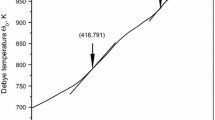Summary
Radioactive heat productionA is a scalar and isotropic petrophysical property independent of in situ temperature and pressure. Its value is usually expressed in HGU units (1 HGU=10−13 cal/cm3 sec) and depends on the amounts of uranium, thorium and potassium.A varies with rock type over several orders of magnitude and reflects the geochemical conditions during rock formation (magmatic differentiation, sedimentation or metamorphism).
In order to assign realistic thermal parameters to deeper-seated rocks correlations with seismic velocity (which can be determined from the surface) have been looked for. In the range characteristic for crystalline rocks of the crust (5–8 km/sec)A is strongly correlated with density and compressional wave velocityv p:A decreases with increasingv p orp. From this relationship it is now possible to estimate heat production values for any particular layer of a crustal section from measured seismic velocities. Contrary to earlier belief there is, as shown by experimental determinations, no correlation between heat productionA and thermal conductivityK in igneous and metamorphic rocks. In sediments however, especially in sand/shale sequences, a correlation betweenK andA is most likely: increasing clay mineral content, characterized by increasingA, causes the decrease ofK in these rocks.
Similar content being viewed by others
References
D. L. Anderson,A seismic equation of state, Geophys. J. Roy. Astron. Soc.,13 (1967), 9.
D. L. Anderson, C. Sammis andT. Jordan,Composition of mantle and core, inThe Nature of the Solid Earth, edited by E. C. Robertson, pp. 41–66, McGraw-Hill, New York (1972).
F. Birch,Heat from radioactivity, inNuclear Geology, edited by H. Faul, pp. 148–174, Wiley & Sons, New York (1954).
F. Birch,The velocity of compressional waves in rocks to 10 kilobar, 2, J. Geophys. Res.66 (1961), 2199.
C. Brunée andH. Voshage,Massenspektrometrie, Thiemig, München (1964).
S. P. Clark, Z. E. Peterman andK. S. Heier,Abundances of uranium, thorium and potassium, inHandbook of Physical Constants, edited by S. P. Clark, pp. 521–542 Geol. Soc. Amer. Memoir97, Washington (1966).
K.-I. Horai andA. Nur,Relationship among terrestrial heat flow, thermal conductivity and geothermal gradient, J. Geophys. Res.75 (1970), 1985.
P. M. Hurley andH. Fairbairn,Radiation damage in zircon: A possible age method, Bull. Geol. Soc. Amer.64 (1953), 659.
E. K. Hyde, I. Perlman andG. T. Seaborg,The Nuclear Properties of the Heavy Elements. II. Detailed Radioactive Properties, Prentice Hall, Englewood Cliffs, N.J. (1964).
L. R. Johnson andH.-R. Wenk,Anisotropy of physical properties in metamorphic rocks, Tectonophys.23 (1974), 79.
H. Leutz, G. Schultz andH. Wenninger,Decay of potassium 40, Z. Physik187 (1965), 151.
N.-H. Mao,Velocity-density systematics and its implications for the iron content of the mantle, J. Geophys. Res.79 (1974), 5447.
J. E. Nafe andC. L. Drake, inM. Talwani, G. A. Sutton andJ. L. Worzel,A crustal section across the Puerto Rico Trench, J. Geophys. Res.64 (1959), 1545.
L. Rybach,Wärmeproduktionsbestimmungen an Gesteinen der Schweizer Alpen. Beitr. Geol. Schweiz, Geotechn. Ser. Lfg. 51, Kümmerly & Frey, Bern (1973).
L. Rybach,Radioactive heat production: A physical property determined by the chemistry of rocks, inProc. NATO Adv. Study Inst. on Petrophysics, Wiley & Sons, New York (in press).
T. J. Shankland,Velocity-density systematics: Derivation from Debye theory and the effect of ionic size, J. Geophys. Res.77 (1972), 3750.
H. Wakita, H. Nagasawa, S. Uyeda andH. Kuno,Uranium, thorium and potassium contents of possible mantle materials, Geochem. J.1 (1967), 183.
H. R. Wenk andE. Wenk,Physical constants of Alpine rocks (Density, porosity, specific heat, thermal diffusivity and conductivity), Schweiz. Min. Petr. Mitt.49 (1969), 343.
Author information
Authors and Affiliations
Additional information
Contribution No. 111, Institute of Geophysics, Swiss Federal Institute of Technology, Zurich, Switzerland.
Rights and permissions
About this article
Cite this article
Rybach, L. Radioactive heat production in rocks and its relation to other petrophysical parameters. PAGEOPH 114, 309–317 (1976). https://doi.org/10.1007/BF00878955
Received:
Issue Date:
DOI: https://doi.org/10.1007/BF00878955



